The association between number of doctors per bed and readmission of elderly patients with pneumonia in South Korea
- PMID: 28595583
- PMCID: PMC5465556
- DOI: 10.1186/s12913-017-2352-7
The association between number of doctors per bed and readmission of elderly patients with pneumonia in South Korea
Abstract
Background: There is an urgent need to reduce readmission of patients with pneumonia and improve quality of care. To assess the association between hospital resources and quality of care, we examined the effect of number of doctors per bed on 30-day readmission and investigated the combined effect of number of doctors per bed and number of beds.
Methods: We used nationwide cohort sample data of health insurance claims by the National Health Insurance Service (NHIS) from 2002 to 2013. Pneumonia admissions to acute care hospitals among 7446 inpatients older than 65 were examined. We conducted a multivariate Cox proportional hazard model to analyze the association between the number of doctors per bed and 30-day readmission, as well as that of pneumonia-specific 30-day readmission with the combined effects of number of doctors per bed and number of beds.
Results: Overall, 1421 (19.1%) patients were readmitted within 30 days and 756 (11.2%) patients were readmitted for pneumonia within 30 days. Patients with pneumonia treated by very low or low number of doctors per bed showed higher readmission (pneumonia-specific readmission: hazard ratio [HR] = 1. 406, 95% confidence interval [CI] = 1.072-1.843 for low number of doctors per bed; all-cause readmissions: HR = 1.276, 95% CI = 1.026-1.587 for very low number of doctors per bed, and HR = 1.280, 95% CI = 1.064-1.540 for low number of doctors per bed).
Conclusions: This empirical study showed that patients with pneumonia cared for in hospitals with more doctors were less likely to be readmitted. Pneumonia-specific 30-day readmission was also significantly associated with the combined effect of the number of doctors and the number of hospital beds.
Keywords: Number of doctors per bed; Pneumonia; Readmission.
Figures


Similar articles
-
Effects of Physician Volume on Readmission and Mortality in Elderly Patients with Heart Failure: Nationwide Cohort Study.Yonsei Med J. 2018 Mar;59(2):243-251. doi: 10.3349/ymj.2018.59.2.243. Yonsei Med J. 2018. PMID: 29436192 Free PMC article.
-
Readmission rates of South Korean psychiatric inpatients by inpatient volumes per psychiatrist.BMC Psychiatry. 2016 Apr 8;16:96. doi: 10.1186/s12888-016-0804-y. BMC Psychiatry. 2016. PMID: 27059818 Free PMC article.
-
Length of stay and readmission in lumbar intervertebral disc disorder inpatients by hospital characteristics and volumes.Health Policy. 2016 Sep;120(9):1008-16. doi: 10.1016/j.healthpol.2016.08.004. Epub 2016 Aug 17. Health Policy. 2016. PMID: 27568166
-
Which Clinical and Patient Factors Influence the National Economic Burden of Hospital Readmissions After Total Joint Arthroplasty?Clin Orthop Relat Res. 2017 Dec;475(12):2926-2937. doi: 10.1007/s11999-017-5244-6. Clin Orthop Relat Res. 2017. PMID: 28108823 Free PMC article.
-
The performance of US hospitals as reflected in risk-standardized 30-day mortality and readmission rates for medicare beneficiaries with pneumonia.J Hosp Med. 2010 Jul-Aug;5(6):E12-8. doi: 10.1002/jhm.822. J Hosp Med. 2010. PMID: 20665626
Cited by
-
Reasons and Risk Factors for Readmission Following Hospitalization for Community-acquired Pneumonia in South Korea.Tuberc Respir Dis (Seoul). 2020 Apr;83(2):147-156. doi: 10.4046/trd.2019.0073. Epub 2020 Mar 10. Tuberc Respir Dis (Seoul). 2020. PMID: 32185918 Free PMC article.
-
Risk factors for hospital readmissions in pneumonia patients: A systematic review and meta-analysis.World J Clin Cases. 2022 Apr 26;10(12):3787-3800. doi: 10.12998/wjcc.v10.i12.3787. World J Clin Cases. 2022. PMID: 35647168 Free PMC article.
-
An Empirical Investigation of "Physician Congestion" in U.S. University Hospitals.Int J Environ Res Public Health. 2019 Mar 2;16(5):761. doi: 10.3390/ijerph16050761. Int J Environ Res Public Health. 2019. PMID: 30832384 Free PMC article.
-
Predicting 30-day readmissions in pneumonia patients using machine learning and residential greenness.Digit Health. 2025 Apr 3;11:20552076251325990. doi: 10.1177/20552076251325990. eCollection 2025 Jan-Dec. Digit Health. 2025. PMID: 40190332 Free PMC article.
References
-
- Jung K-S. Pneumonia in the elderly patients. Korean J Med. 2008;75(2):129–140.
-
- Statistics Korea. 2013. Available from: http://kosis.kr/statisticsList/statisticsList_01List.jsp?vwcd=MT_ZTITLE&.... Accessed 5 Mar 2016.
MeSH terms
LinkOut - more resources
Full Text Sources
Other Literature Sources
Medical

